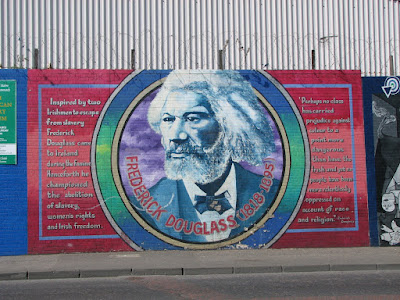







From there we drove into Belfast and found a Black Taxi Tour - basically a private tour for a small group with a knowledgeable driver who explained the history of the conflict in Northern Ireland, gave us some perspective on what life is like today in Belfast, and answered any questions we had. I was really impressed with how unbiased he was. We tried to speculate as to whether he was Catholic or Protestant, but we couldn't tell.
First he took us to a Protestant neighborhood to see some of the murals on the homes and buildings. Some of them depict historical scenes, while others are memorials to those who died in the conflict. One of the murals was in remembrance of a member of one Protestant militia group who was murdered by a different Protestant group. Sometimes it seems like the human capacity for discord and violence is endless. I also noticed racist graffiti and stickers in one of the neighborhoods we walked in. Seriously, why can't we all just get along?












Then we traveled into a Catholic neighborhood where the driver showed us some of the memorial gardens that the communities have established.



There's a huge wall between the Protestant and Catholic areas of the city. You can see here where the government has installed grates on the back of the houses near the wall because people on the other side will lob bricks and bottles, which were breaking windows and landing in homes.

Despite the relative peace for the last 14 years, the wall is being built taller and stronger all the time. Our guide seemed to think the wall contributed greatly to that peace, rather than any deep sense of love and understanding among the populace. According the driver, even streets that aren't behind walls are largely segregated, and Catholics and Protestants lead mostly separate lives within Belfast.


This graffiti stands for "kill all taigs," a slur against the Catholics. There's definitely still at least some anger between the two sides. It makes me hopeful though, that a new generation is coming of age without having experienced the bombings and killings.

These are murals by the Catholics in honor of other oppressed (or "oppressed" depending on your political leanings) peoples around the world with whom the Catholics identify and feel affinity, such as the Cubans, Basques, Palestinians, and Iraqis.




The Catholics also created murals commemorating their dead in the conflict, such as these in honor of Bobby Sands and other hunger strikers who died protesting the treatment of Catholic political prisoners.


As our guide kept reminding us, people on both sides fought, killed, and died for their lives and freedom and homes because they believed what they were doing was right. I left Northern Ireland with the sense that many were also striving for peace, and I hope they prevail.



1 comment:
Every city has it’s shopping and coffee culture but Belfast city has a unique past after coming out of 35 years of conflict.
http://www.belfastblacktaxitours.com The North of Ireland has become famous for the murals painted in almost every area of the country. These pictures of murals are often flashed around the world on news bulletins or used as a backdrop when interviewing people. They often depict the history and political views of both traditions and are a way of marking territory. These wall paintings often look intimidating but they have become as much of a tourist attraction as many of the regular attractions within Belfast and beyond.
Post a Comment